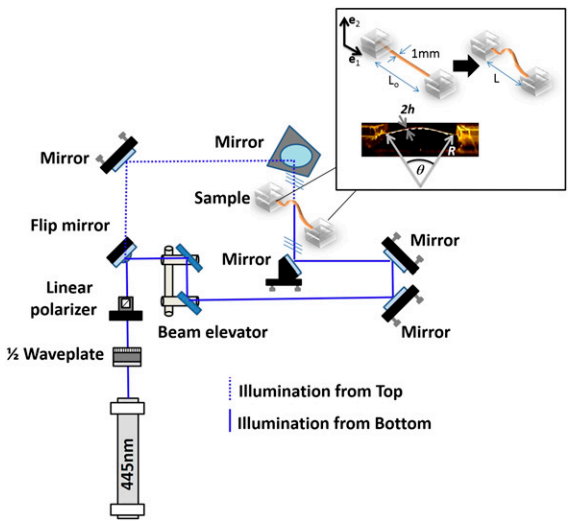Controlling devices with a beam of light
November 14, 2013

Arch-shaped samples were created using an azobenzene-functionalized polymer that deforms when irradiated with light (blue). The design of the device triggers an elastic instability when it reaches a certain configuration when irradiated and “snaps” to deliver a large amount of power at millisecond time scales. (Credit: M. Ravi Shankar et al./University of Pittsburgh)
University of Pittsburgh and Air Force Research Laboratory researchers are investigating polymers that “snap” when triggered by light, thereby converting light energy into mechanical work and potentially eliminating the need for traditional machine components such as switches and power sources.
“Learning from ideas observed in the natural world, we created mechanical designs that generate ultrafast actuation when triggered with light,” M. Ravi Shankar, lead author of the study and associate professor of industrial engineering in the University’s Swanson School of Engineering, told KurzweilAI. “This allowed us to generate actuation at millisecond time-scales and power densities approaching kilowatts per cubic meter” at radiation intensities far less than 100 milliwatts per square centimeter and potentially over long distances.

Experimental setup used for irradiating arches created from photoactive materials from the top and bottom using a 445-nm laser with polarization set parallel to the long-axis of the arch. (Inset) Creation of a bistable arch that is examined for photomechanical snap-through in this study. (Credit: M. R. Shankar et al./Proceedings of the National Academy of Sciences)
“I like to compare this action to that of a Venus flytrap,” he said. “The underlying mechanism that allows the Venus flytrap to capture prey is slow. But because its internal structure is coupled to use elastic instability, a snapping action occurs, and this delivers the power to shut the trap quickly. A similar mechanism acts in the beak of the Hummingbird to help snap-up insects
“You could activate a switch simply by shining light on it,” Shankar says. “For example, you could develop soft machines such as stents or other biomedical devices that can be more adaptive and easily controlled. In a more complex mechanism, we could imagine a light-driven robotic or morphing structure, or microvehicles that would be more compact because you eliminate the need for an on-board power system. The work potential is built into the polymer itself and is triggered with light.”
The research could “drive microfluidics and biomedical devices, power microrobots and actuators without using onboard power systems or wiring or even create morphing structures and surfaces that transform when suitably irradiated with light,” Shankar explained to KurzweilAI. However, “we are still at the fundamental research level and the opportunities for new system designs are being examined.”
UPDATE Nov. 14, 2013: Added after “”This allowed us to generate actuation at millisecond time-scales and power densities approaching kilowatts per cubic meter”: “at radiation intensities far less than 100 milliwatts per square centimeter and potentially over long distances.” Also added experimental setup illustration.
Abstract of PNAS paper
